
Leucopogon plumuliflorus is a species of flowering plant in the heath family Ericaceae and is endemic to the south-west of Western Australia. It is a weakly erect shrub with egg-shaped leaves and spikes of white or pinkish-white, tube-shaped flowers.

Leucopogon tamminensis is a species of flowering plant in the heath family Ericaceae and is endemic to the southwest of Western Australia. It is a slender shrub with many branches, overlapping triangular to egg-shaped leaves and white, tube-shaped flower arranged singly in upper leaf axils.
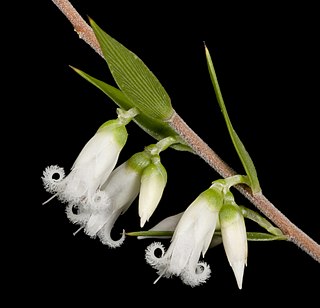
Styphelia conostephioides is a flowering plant in the family Ericaceae and is endemic to the south-west of Western Australia. It is an erect, straggling shrub with lance-shaped leaves with a sharp point on the tip, and white flowers arranged in pairs in leaf axils.

Styphelia crassifolia is a species of flowering plant in the family Ericaceae and is endemic to [the south-west of Western Australia. It is an erect, bushy shrub that typically grows to a height of 60 cm (24 in). Its leaves are oblong, 4–9 mm (0.16–0.35 in) long on a short petiole, with 3 prominent ribs on the lower surface. One or two flowers are borne in leaf axils on a short peduncle with tiny bracts and bracteoles about half the length of the sepals. The sepals are about 1.6 mm (0.063 in) long and the petals are about 3.2 mm (0.13 in) long and joined at the base, the lobes about as long as the tube.
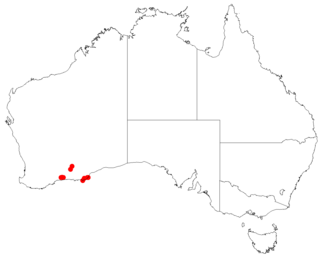
Leucopogon bossiaea is a species of flowering plant in the heath family Ericaceae and is endemic to a restricted area in the south-west of Western Australia. It is an erect shrub with elliptic to broadly egg-shaped leaves and white flowers in four to eleven upper leaf axils.
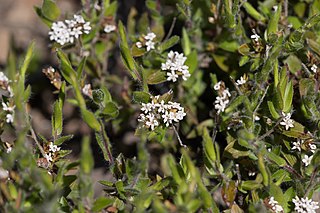
Leucopogon concurvus is a species of flowering plant in the heath family Ericaceae and is endemic to a restricted part of South Australia. It is a slender shrub with egg-shaped leaves, and white, tube-shaped flowers arranged along the branches.

Styphelia cordifolia, commonly known as heart-leaved beard-heath, is a species of flowering plant in the heath family Ericaceae and is endemic to Australia. It is an erect shrub with broadly egg-shaped to round leaves, and white, tube-shaped flowers, the petals bearded on the inside.

Styphelia allittii is a species of flowering plant in the family Ericaceae and is endemic to the south-west of Western Australia. It is a rigid, glabrous shrub that typically grows to a height of about 30 cm (12 in) and has egg-shaped or lance-shaped leaves and tube-shaped, white flowers.

Styphelia blepharolepis is a species of flowering plant in the heath family Ericaceae and is endemic to the south-west of Western Australia. It is an erect shrub with sharply-pointed, oblong to lance-shaped leaves and small flowers in racemes of two to five in leaf axils with small bracts and bracteoles about 1 mm (0.039 in) long. The sepals are about 2 mm (0.079 in) long and the petals are joined at the base forming an urn shape about 4 mm (0.16 in) long with lobes longer than the petal tube.

Styphelia breviflora is a species of flowering plant in the heath family Ericaceae and is endemic to the south-west of Western Australia. It is an erect, spindly, glabrous shrub that typically grows to a height of up to about 1.5 m. It has oblong to lance-shaped or linear leaves 4–9 mm (0.16–0.35 in) long on a short petiole and with a small, rigid point on the tip. The flowers are borne singly or in pairs in leaf axils on a short peduncle with small bracts and bracteoles about half as long as the sepals. The sepals are about 2 mm (0.079 in) long and the petals white and about 4 mm (0.16 in) long, the petal lobes longer than the petal tube.

Styphelia concinna is a species of flowering plant in the heath family Ericaceae and is endemic to the south-west of Western Australia. It is a low-lying shrub with many branches. Its leaves are egg-shaped or oblong, 2–4 mm (0.079–0.157 in) long with a small point on the end and the ends rolled under. The flowers are arranged singly or in pairs in leaf axils on a short peduncle. The sepals, petal tube and petal lobes are about 2 mm (0.079 in) long.
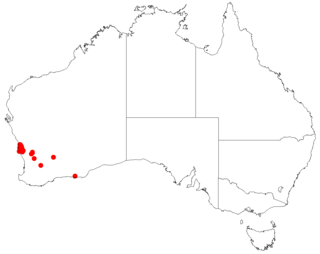
Styphelia crassiflora is a species of flowering plant in the heath family Ericaceae and is endemic to the south-west of Western Australia. It is an erect shrub with few branches and that typically grows to a height of 30–60 cm (12–24 in). Its leaves are broadly egg-shaped with the narrower end towards the base, to more or less round, 2–3 mm (0.079–0.118 in) long with a stem-clasping base. The flowers are borne singly or in pairs in upper leaf axils on a short peduncle, sometimes in small clusters, and with small bracts and bracteoles at the base. The sepals are about 4 mm (0.16 in) long and the petals about 6.5 mm (0.26 in) long, the petal lobes longer than the petal tube.
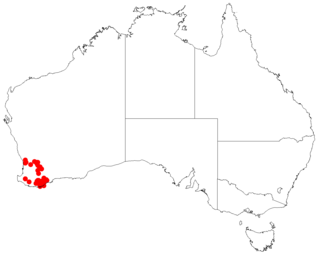
Styphelia cymbiformis is a flowering plant in the family Ericaceae and is endemic to the south-west of Western Australia. It is a bushy or wiry shrub that typically grows to a height of 30–50 cm (12–20 in) and has more or less glabrous branches. Its leaves are erect, linear to lance-shaped and sharply-pointed, mostly 2–4 mm (0.079–0.157 in) long. The flowers are arranged in short spikes, sometimes of only two or three flowers, with lance-shaped, leaf-like bracts, and bracteoles half as long as the sepals at the base of the spikes. The sepals are 2.5–3.0 mm (0.098–0.118 in) long and the petals slightly longer than the sepals, the lobes shorter than the petal tube.

Styphelia exolasia, commonly known as Woronora beard-heath, is a species of flowering plant in the heath family Ericaceae and is endemic to a small area of New South Wales. It is an erect shrub with oblong or elliptic leaves, and drooping, white, tube-shaped flowers.

Leucopogon opponens is a species of flowering plant in the heath family Ericaceae and is endemic to the south-west of Western Australia. It is an erect, slender shrub with its leaves arranged in opposite pairs, and white, tube-shaped flowers.
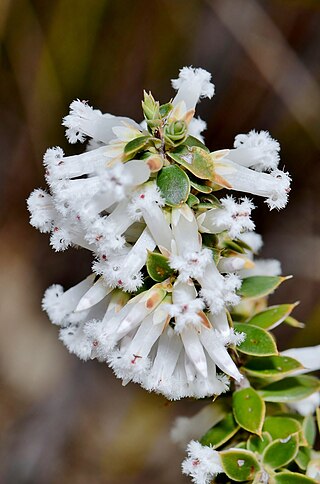
Styphelia erubescens is a species of flowering plant in the heath family Ericaceae and is endemic to the south-west of Western Australia. It is an erect shrub with variably-shaped leaves with a small, sharp point on the tip, and white, pink or red, tube-shaped flowers.

Leucopogon strongylophyllus is a species of flowering plant in the heath family Ericaceae and is endemic to the southwest of Western Australia. It is an erect shrub with crowded egg-shaped or round leaves and white, tube-shaped flower arranged singly or in pairs in leaf axils.
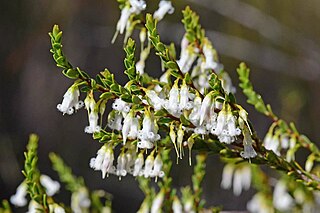
Leucopogon woodsii, commonly known as nodding beard-heath, is a species of flowering plant in the heath family Ericaceae and is endemic to southern continental Australia. It is a slender shrub with more or less erect, egg-shaped leaves, and pendent white, tube-shaped flowers with densely bearded lobes.
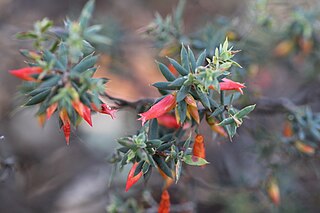
Styphelia epacridis is a flowering plant in the family Ericaceae and is endemic to the south-west of Western Australia. It is a straggling shrub with lance-shaped or linear leaves with a sharp point on the tip, and red, tube-shaped flowers arranged singly in leaf axils.

Styphelia exarrhena, commonly known as desert styphelia, is a species of flowering plant in the heath family Ericaceae and is endemic to southern continental Australia. It is an erect shrub with erect or spreading egg-shaped leaves, and cream-coloured, tube-shaped flowers arranged singly or in pairs in upper leaf axils.



















